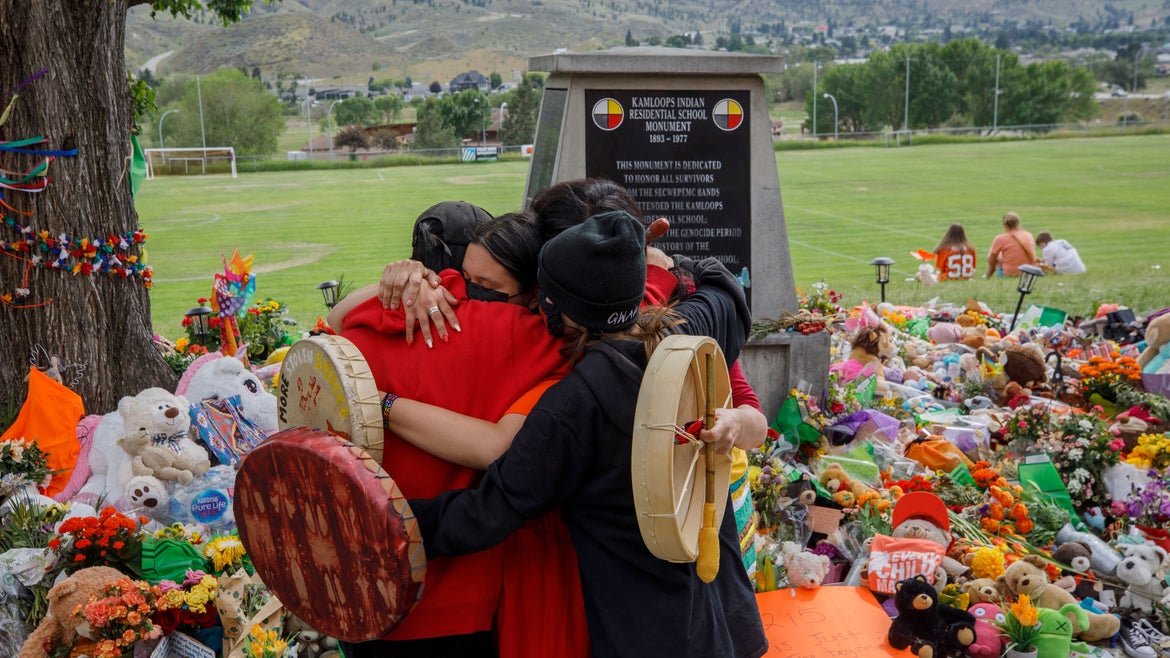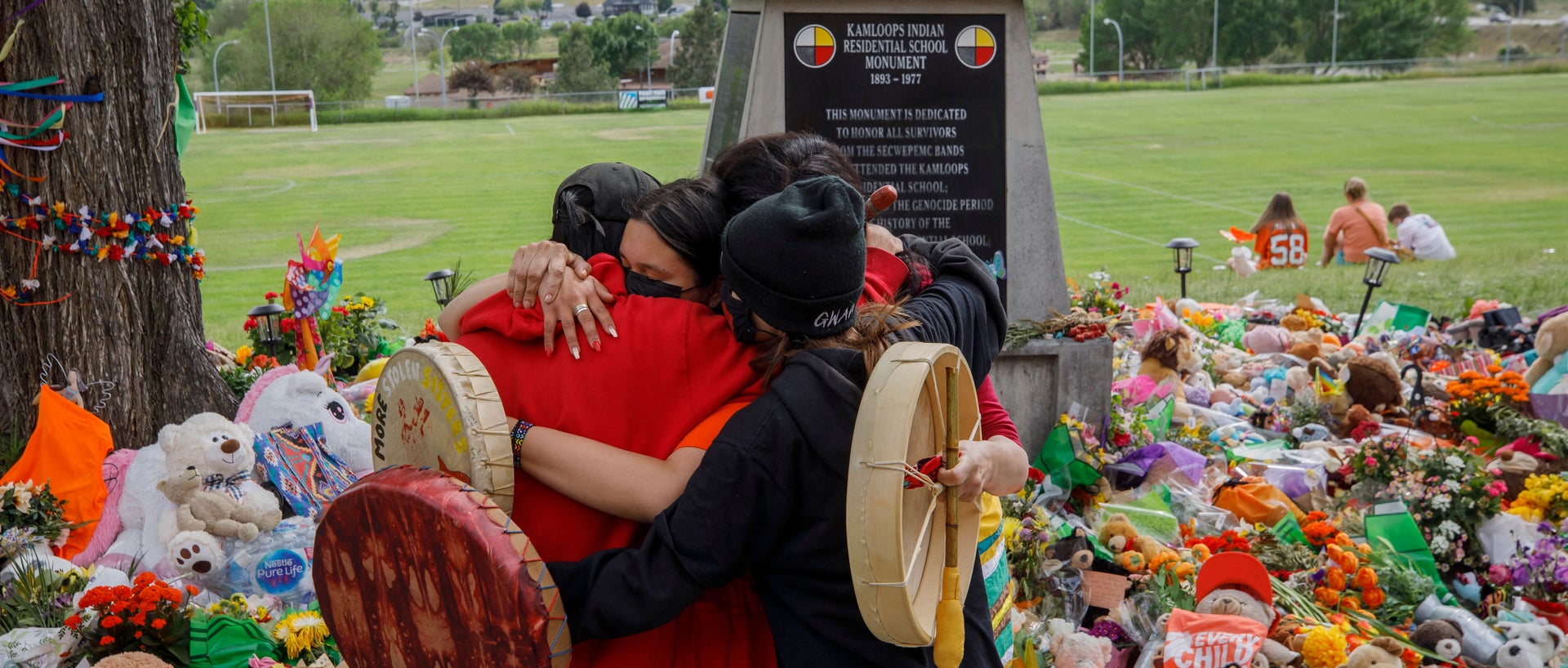Last weekend, hundreds embarked on a three-day walk along the South Thompson River, from the former Kamloops Residential School to the nearby city of Chase organized by the Adams Lake Indian Band.
Tributes honoring the 215 Indigenous children whose bodies were found buried at the former Kamloops Residential School in British Columbia continue nearly a month after the gruesome discovery of the remains was made.
Last weekend, hundreds embarked on a three-day walk along the South Thompson River, from the former Kamloops Residential School to the nearby city of Chase organized by the Adams Lake Indian Band. Their goal for the walk, aptly named Walking Our Spirits Home, was to arrive at Shuswap, with the belief that they would reclaim the lost spirits of the 215 Indigenous children along the way.
"There are a lot of lost spirits and souls, and … everyone that has been at the school has left a piece of them there," Cliff Arnouse, the band’s Kukpi7 or chief, told Daybreak Kamloops.
The walk, filled with prayer and tobacco being sprinkled along the way, is reminiscent of semi-regular walks organized along the Highway of Tears, which spans from nearby Prince George to Prince Rupert. Nearly 100 people have gone missing along that route over the years, and the majority of the victims are Indigenous women.
Meanwhile, the Indigenous community in Alaska hosted a vigil in Juneau last weekend in solidarity with their Canadian neighbors. “The same thing that happened in Canada happened in Alaska,” organizer Jennifer Brown, who is Tlingit, told KTOO.
Tlingit Elder Leona Santiago also spoke at the vigil, recounting her own memories of residential school. Santiago said she was taken from her family at the age of 2, and finally returned to them at 15. She added that her grandparents would have had it worse.
Closer to Kamloops, British Columbia’s Douglas College in New Westminster, Russ Baker Way in Richmond, Walton Elementary School in Coquitlam, and Veterans Park in Port Coquitlam, also hosted their own memorials with orange ribbons.
Orange is used to honor the missing Indigenous children that never returned from residential school. Every year on Sept. 30, Canada observes the National Day of Truth and Reconciliation, sometimes known as Orange Shirt Day for the color people are encouraged to wear.
The ongoing spotlight on residential schools and healing Canada’s relationship with Indigenous communities has led some to question what has been seen as racist and stereotypical language that continues to be used surrounding Indigenous people.
“I very much was overwhelmed and I cried a lot that day. It was very hurtful,” tenth grader Malaika Joudry-Martel of Nova Scotia told CBC News when she read an assignment asking her to list reasons why poverty, alcoholism and unemployment are high among First Nations populations.
Malaika is Mi'kmaw and a student of the province’s correspondence courses, meaning her studies are online. While she has no designated teacher, she still submits courses to be graded.
Another assignment asked her to list the “benefits and disadvantages of being placed in a residential school.” The assignment claimed some had “positive” experiences in the institution long touted by Indigenous leaders and the Government of Canada as a form of cultural genocide and ethnic cleansing.
Her mom shalan joudry, who spells her name in lowercase, explained that there are people in their community of L'sɨtkuk, or Bear River, that had been sent to the Shubenacadie Residential School and “did not come home well,” CBC News reported.
“We today are living with the effects of that school,” joudry said. “This is going against the flow of where we want to head in reconciliation.”
She shared her outrage in a Facebook post that quickly went viral, and eventually caught the attention of the province’s Education Minister, who acknowledged in an email to all students of the class that the content was “unacceptable” and “is being removed immediately.”
“We apologize for the insensitivity of this material,” the email, shared on jourdry’s Facebook page, stated. “At the Department of Education and Early Childhood Development, we have made a commitment to Reconciliation, which includes Treaty Education, and this content in the course does not meet that commitment.”
jourdry went on to thank her supporters for helping them put pressure on the Department of Education, but added “there is work to do, my friends. Let’s not be blind.”
Indigenous leader Elder Taz Augustine, who refers to herself as a descendent of the Original People of the land, expressed outrage about a post on social media insinuating Indigenous children at residential schools “[were] having an absolute blast.”
The tweet was shared alongside a photo allegedly depicting a group of Indigenous children at the Cecilia Jeffrey Indian Residential School in Ontario atop a dilapidated playground, smiling for the camera.
“How dare he think these children were having fun at a playground,” Augustine said, according to Global News. “Any picture can be altered, any picture can be postured where the children are placed in such a position and they can be told and demanded to smile. Any child can be told that because in those schools if they didn’t do what they were told, some of them were killed.”
Augustine organized for 215 miniature tipis, meant to represent each of the children found buried in the mass grave, to be made and placed in front of St. Basilica Church in Edmonton earlier this month. “We choose it as a site because it is a Catholic church and 70 per cent of residential schools were run by the Catholic Church,” she told CTV News Edmonton. “It is important that we hold them accountable.”
The Dorchester Review, a controversial history journal, had penned the original post, and continued to double down in its claim that Indigenous children had fun at residential schools
They later shared a tweet honoring Egerton Ryerson, the founder of Canada’s residential school system. A statue of Ryerson was knocked down by outraged protesters earlier this month, and the school bearing his name is undergoing a name change in acknowledgement of his wrongdoings.
The Dorchester Review’s editor is Chris Champion, who was also hired to develop part of Alberta’s elementary school curriculum, Global News reported, adding that many criticize its inaccuracies surrounding its teachings of First Nations, Métis and Inuit history.
Most Alberta schools say they will not use his curriculum in classrooms this coming year, Global News reported.







